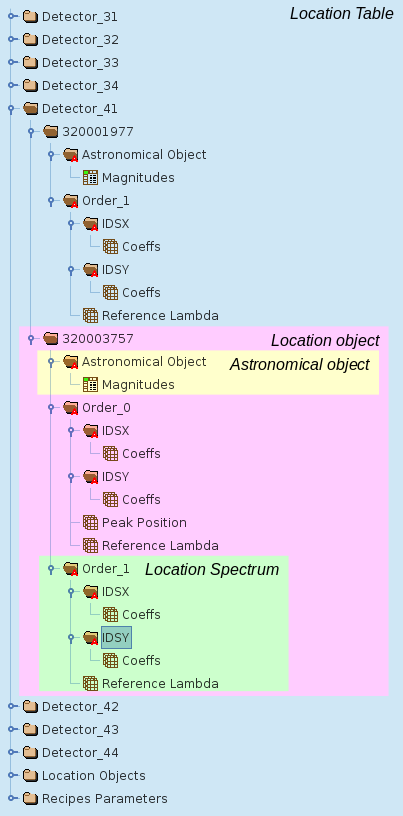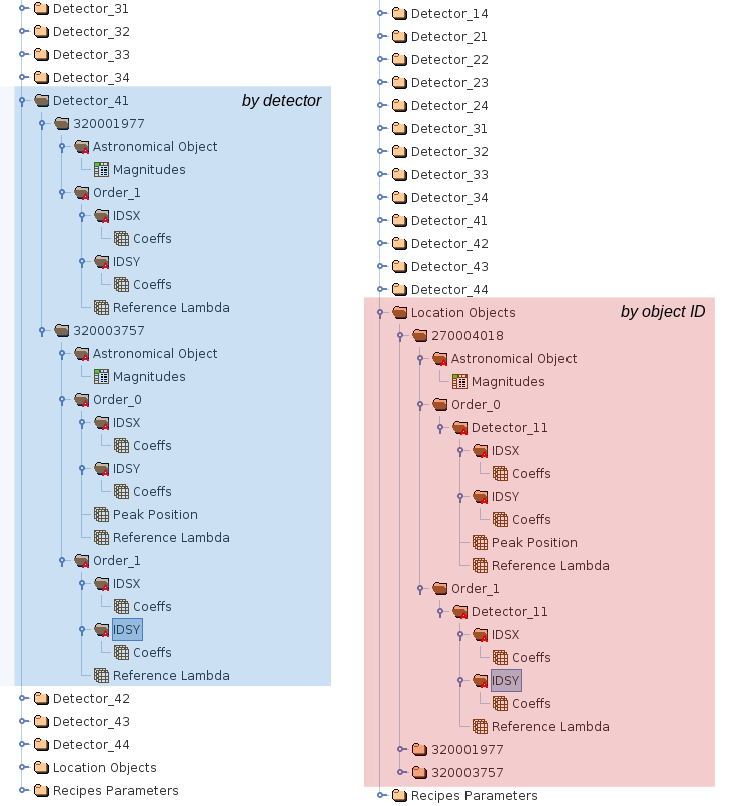Location Table Product¶
Data product name¶
LocationTable
Data product custodian¶
SIR
Data model tag¶
R-1.6.6
Name of the Schema file¶
euc-test-sir-LocationTable.xsd
Schema documentation tag¶
No documentation element was found in schema file! Data Model custodian: even minimal information can be helpful
Data product elements¶
Header of type: sys:genericHeader
Data of type: sir:genericSirCollection
Parameters of type: ppr:genericKeyValueParameters
Processing Element(s) creating/using the data product¶
This data product is produced by the SIR_SpectraLocation PE.
It is used by SIR_BackgroundSubtraction, SIR_SpectraDecontamination and SIR_SpectraExtraction PEs.
Processing function using the data product¶
This is an internal data product. It is used only by SIR-PEs.
Detailed description of the data product¶
The main purpose of the LocationTable is to gather information to locate and extract spectra on the detectors. LocationTable is an hierarchical organization of LocationSpectra, AstronomicalObjects and LocationObjects.
Each object in the field of view produces spectra of different orders. The LocationSpectrum describes every spectral trace (of every orders) produced on the detectors. A single spectrum can involve multiple detectors; in this case one LocationSpectrum for each detector is created. The LocationSpectrum is the atomic component of the LocationTable.
LocationSpectra which refer to the same target are collected into the LocationObject. The LocationObject contains also the AstronomicalObject which describes physical properties of the target.
The LocationTable data product is the hierarchical collection of LocationObject of all available targets.
Each one of these objects (LocationSpectrum, LocationObject, AstronomicalObject and LocationTable) is serialized as HDF5 group into the HDF5 file. These 4 objects will be described in details in the next paragraphs.

Fig. 21 : Location Table HDF5 file structure.¶
Location Spectrum group¶
Due to optical distortions and uncertainty in grism alignment, dispersed spectra are curved and not perfectly aligned with the dispersion direction. Since this curvature changes moving around the the FOV, each spectrum has it own curvature and it own inverse wavelength solution. These 2 properties are different spectrum by spectrum. For this reason the SIR_Pipeline has to produce one LocationSpectrum (green box in Fig. 21) for each spectrum in the FOV.
The LocationSpectrum group contains information about geometry of the spectrum and it is used to locate spectral wavelengths on the detector. This is performed by:
Setting a lambda reference value
this value is defined by the attribute Offset of the IDSX and IDSY groups.
Identifying the positions on the detector of this lambda reference value along the cross-dispersion direction
these positions are defined by The Reference lambda dataset. This dataset is a n by 2 matrix, each row defines the pixel where the reference lambda is. Number of rows changes object by object according with object size and angle.
Applying polynomial solutions: along X and Y directions.
the IDSX and IDSY groups contain the Coeffs dataset: the polynomial coefficients of the wavelength solution. Each row is a set of polynomial coefficients; the number of rows of this dataset must be identical to the number of rows of the Reference lambda dataset.
Finally the LocationSpectrum contains attributes used to uniquely identify the spectrum:
the target ID
the Order of the spectrum itself
the Grism Position: 0, 90 or 180
the Detector involved by the spectrum
the Exposure ID
the Field ID
Astronomical Object group¶
The AstronomicalObject (yellow box in Fig. 21) gathers the astronomical properties of the target using the attributes:
Angle of the object in the sky
Bulge fraction of the target
Y-H Color
Dec and RA coordinates
object ID
Major axis and Minor axis of the object
object Type; at the moment only star (1) and galaxy (2) are implemented
Beside these values the AstronomicalObject also contains infrared magnitudes of the objects. The Magnitudes complex type table has 3 columns:
the magnitude Band
Vega flag: 1 if the magnitude is in the Vega system, 0 if not
the magnitude Value
Location Object group¶
The LocationObject (purple box in Fig. 21) collects together spectra with the same target ID; it combines one AstronomicalObject and several LocationSpectra.
Location Table group¶
The LocationTable (cyan box in Fig. 21) data product gathers LocationObjects and organizes them according with 2 different criteria:
In the Detector_n groups LocationObjects are organized detector by detector (blue box in Fig. 22). Each LocationObject in one of these groups contains only spectra produced on the n-th detector.
In the Location Objects group LocationObjects are organized by ID (red box in Fig. 22). LocationObject in this group gathers all spectra in the FOV with the same target ID.

Fig. 22 : Different hierarchy in the Location Table.¶
Finally the Reduction Recipes group contains one attribute for each input parameter of the SIR_Pipeline task used to create the LocationTable itself.